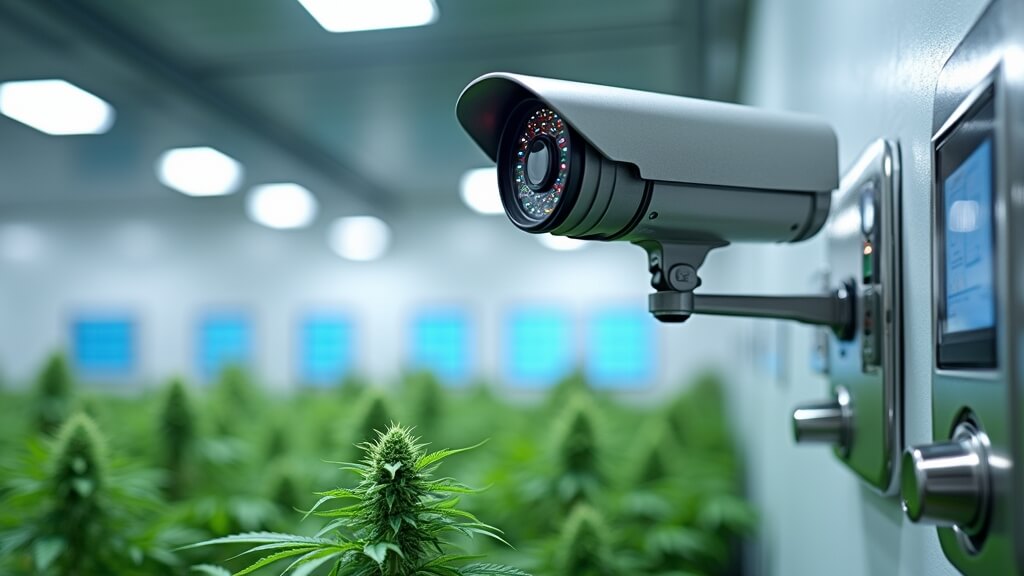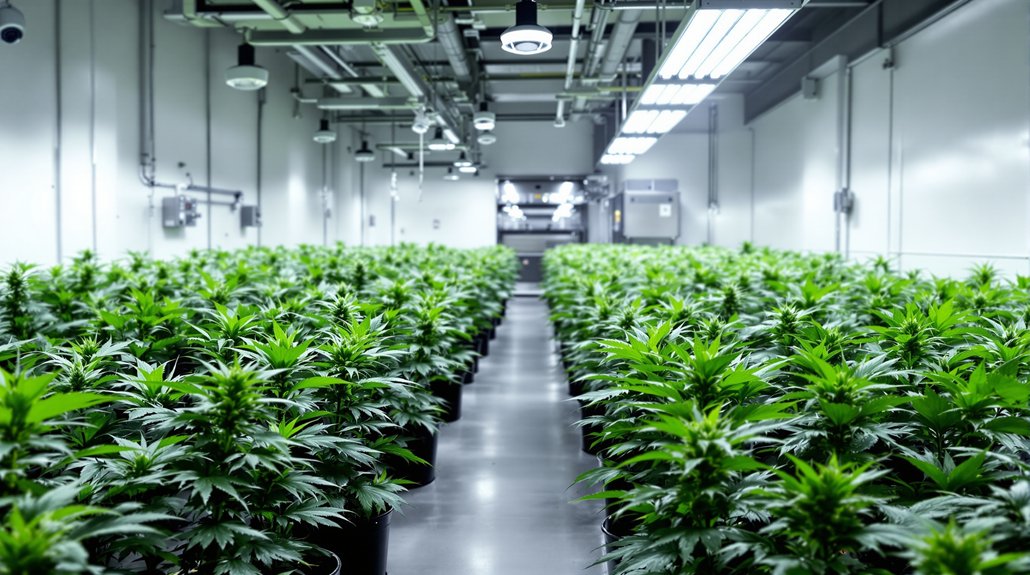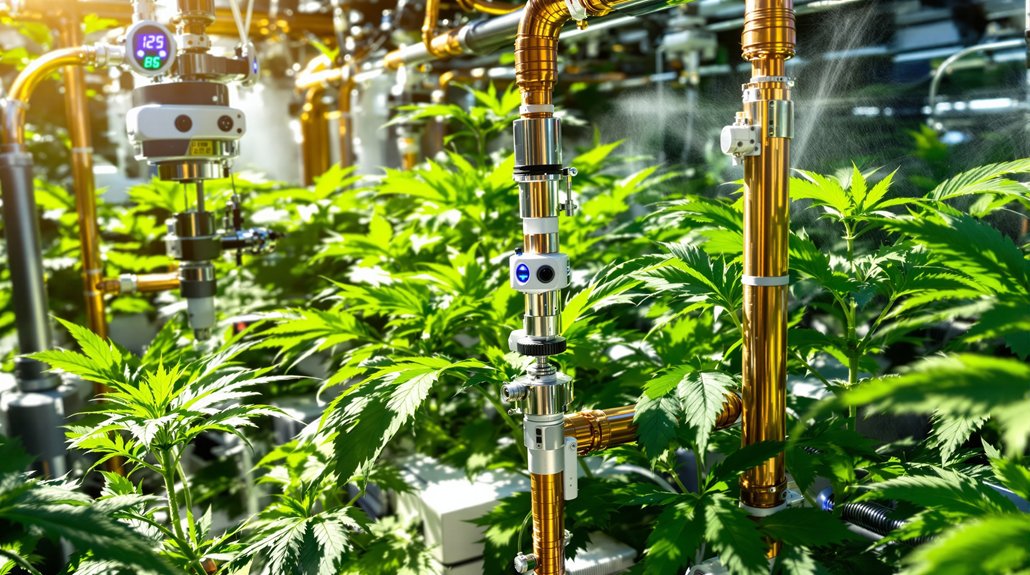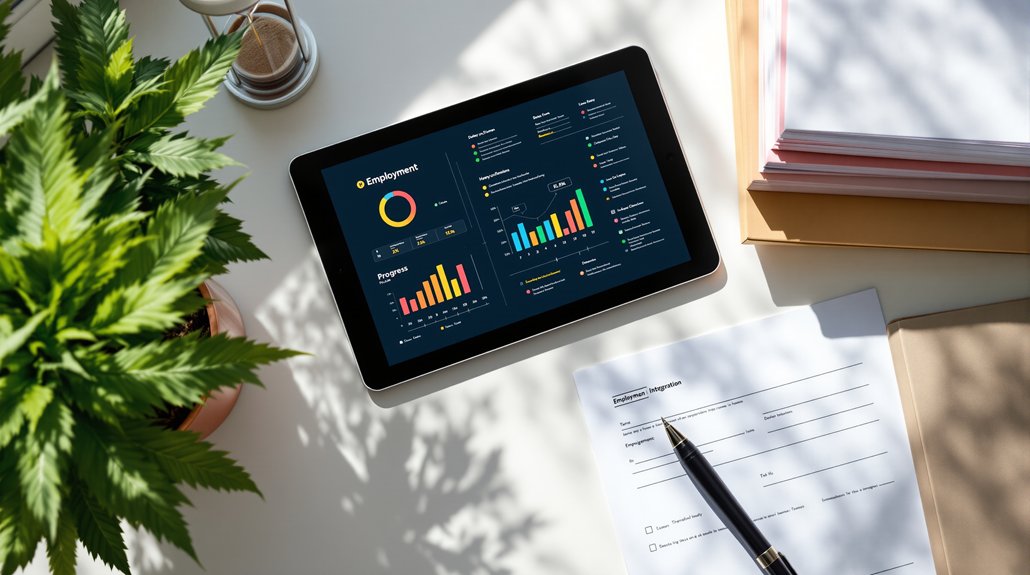Cannabis businesses operate under some of the most stringent security regulations in any industry, with violations potentially resulting in immediate license revocation and business closure. State authorities mandate thorough protection systems that span physical infrastructure, digital networks, and regulatory documentation. Operators face complex requirements that vary greatly by jurisdiction, creating compliance challenges that can overwhelm even experienced business owners. The consequences of inadequate security measures extend far beyond regulatory penalties.
Physical Security Infrastructure and Access Control Systems
Cannabis businesses face the most comprehensive physical security requirements in commercial real estate, with regulations that vary dramatically between states and business types. Understanding these requirements during the planning phase prevents costly retrofits and ensures smooth licensing approval processes.
State Requirements and Regulatory Variations
Physical security standards differ significantly across cannabis markets, creating complex compliance challenges for multi-state operators. California mandates 8-foot perimeter fencing with approved materials, while Colorado requires 6-foot barriers but allows greater flexibility in barrier types. Washington focuses heavily on access control integration, requiring electronic systems that interface with surveillance networks, while Oregon emphasizes lighting standards with specific foot-candle measurements at property boundaries.
Florida’s medical cannabis regulations require vault-style storage rooms with concrete walls, while Michigan allows secure storage in reinforced metal cabinets meeting specific gauge requirements. New York demands biometric access controls for all restricted areas, while Pennsylvania accepts keycard systems with proper audit trail capabilities.
Business type significantly affects security requirements within each state. Cultivation facilities typically face the most stringent perimeter security demands, with some states requiring double-barrier systems and motion detection zones. Retail dispensaries must focus on point-of-sale security and customer area monitoring, while manufacturing facilities need specialized protections for extraction equipment and chemical storage areas.
Perimeter Security and Access Control Implementation
Barrier and Lighting Requirements
Perimeter security begins with proper barrier selection that meets state specifications while providing practical protection. Most states require solid barriers preventing visual observation of cannabis operations, with height requirements ranging from 6 to 10 feet depending on jurisdiction.
Chain-link fencing with privacy slats is usually the most cost-effective option at $15-25 per linear foot installed. Concrete block walls ($35-50 per linear foot) provide enhanced security and professional appearance, while steel panel systems ($25-40 per linear foot) offer middle-ground solutions with excellent durability.
Gate systems require careful attention to access control integration and emergency response capabilities. Automated gates with card reader access can cost between $3,000-8,000 installed, while manual gates with electronic locks run $1,500-4,000. Emergency responder access provisions must comply with local fire codes, often requiring Knox Box systems.
Exterior lighting must achieve minimum 2-foot-candle illumination at property boundaries, with higher levels mandated near entrances. LED flood lighting provides cost-effective solutions at $200-600 per fixture, while professional lighting design ($2,000-5,000) ensures optimal illumination patterns that support security objectives.
Access Control Systems
Modern cannabis facilities need sophisticated access control systems that integrate with surveillance and alarm networks while maintaining detailed audit trails. Card reader systems start at $1,500 per door for basic solutions, reaching $5,000+ per access point for enterprise systems. Biometric systems cost $3,000-8,000 per reader but eliminate card sharing issues that regulators scrutinize.
Multi-factor authentication combining cards with PIN codes or biometric verification costs 40-60% more than single-factor solutions but significantly reduces unauthorized access risks. Access control servers require $5,000-15,000 initial investment plus annual maintenance fees of 15-20% of system value.
Pre-installation planning should begin 60-90 days before system activation, including access level design and integration requirements. System installation typically requires 3-5 days for facilities with 10-15 access points, plus additional time for integration testing and regulatory inspection preparation. Staff training requires 2-4 hours per employee covering proper procedures and emergency protocols.
Secure Storage and Implementation Challenges
Storage Requirements and Solutions
Cannabis product storage requirements vary dramatically between states. California requires UL-listed safes or vault rooms with concrete walls and reinforced doors. Florida mandates vault-style storage rooms with 6-inch concrete walls and steel-reinforced doors meeting specific security ratings. Colorado accepts secure storage rooms with reinforced construction, while Michigan requires fireproof safes meeting specific UL ratings.
Commercial safes suitable for cannabis storage can range from $2,000-15,000 depending on size and security rating. TL-15 rated safes provide adequate security for most state requirements, while TL-30 safes offer enhanced protection for high-value storage. Vault room construction costs $15,000-50,000 depending on size and security features, with vault doors alone costing $8,000-25,000.
Dual-control systems requiring two-person access provide enhanced security and regulatory compliance, typically adding $2,000-5,000 to safe or vault costs. Time-delay locks prevent rapid access during robbery attempts but require careful staff training for daily operations.
Common Implementation Mistakes
Many operators underestimate system integration complexity, installing standalone systems that don’t communicate with other security components. This approach fails to meet regulatory expectations and creates operational inefficiencies. Solution: Design integrated security architecture from the outset, budgeting additional 20-30% for system integration compared to standalone component costs.
Inadequate power and network infrastructure represents another critical failure point. Security systems require robust infrastructure that many facilities lack during initial construction. Power failures disable security systems, while network connectivity issues prevent remote monitoring and audit trail generation. Solution: Install uninterruptible power supplies for all security systems and ensure redundant network connections, budgeting $5,000-15,000 for proper infrastructure.
Documentation gaps create licensing delays and regulatory violations even when physical security measures are adequate. Operators often focus on installing systems without properly documenting compliance with state requirements. Solution: Maintain detailed documentation of all security measures, including system specifications, installation certifications, and maintenance records. Consider hiring cannabis-experienced security consultants to ensure comprehensive compliance documentation.

Digital Security Protocols and Cybersecurity Measures
Modern cannabis operations must defend against increasingly sophisticated digital threats that target valuable business data, financial records, and regulatory compliance systems. Cannabis businesses face unique cybersecurity challenges due to banking limitations, high-value inventory data, and extensive regulatory documentation requirements that create attractive targets for cybercriminals.
Regulatory Requirements and Compliance Standards
Cannabis businesses must comply with multiple cybersecurity frameworks depending on their operations and banking relationships. PCI DSS compliance becomes mandatory for any business processing credit card transactions, requiring specific network segmentation, encryption standards, and regular security assessments. SOC 2 Type II audits are increasingly required by cannabis banking partners, demanding documented security controls and annual third-party verification.
State-specific data protection requirements vary significantly across cannabis markets. California businesses must comply with CCPA regulations for customer data protection, requiring explicit consent protocols and data deletion capabilities. New York demands specific cybersecurity protocols for cannabis businesses, including mandatory incident reporting within 72 hours of discovery. Colorado requires cannabis businesses to maintain cyber insurance with minimum coverage amounts, while Washington mandates specific data retention and destruction protocols for customer information.
HIPAA compliance affects medical cannabis operations in all states, requiring comprehensive patient data protection measures including encrypted storage, access controls, and audit trail maintenance. Banking compliance requirements often exceed standard cybersecurity measures, with many financial institutions requiring cannabis businesses to implement enterprise-grade security controls typically reserved for much larger organizations.
Seed-to-sale system security represents a critical compliance area, as these platforms contain comprehensive business data including inventory levels, customer information, and financial transactions. Most states require cannabis businesses to ensure their tracking system vendors maintain adequate cybersecurity measures and provide regular security assessments.
Network Security and Infrastructure Implementation
Firewall and Network Architecture
Cannabis businesses require enterprise-grade network security that protects against both external threats and internal vulnerabilities. Next-generation firewalls with deep packet inspection cost $2,000-15,000 depending on network size and throughput requirements. Network segmentation separating point-of-sale systems, seed-to-sale platforms, and administrative networks prevents lateral movement during security breaches.
Virtual Private Networks (VPNs) become essential for remote access to cannabis business systems, with enterprise solutions costing $5-15 per user monthly. Multi-factor authentication requirements extend beyond simple username/password combinations, typically requiring hardware tokens or mobile authentication apps for all system access.
Intrusion detection and prevention systems monitor network traffic for suspicious activity, with managed solutions costing $1,000-5,000 monthly depending on network complexity. Security Information and Event Management (SIEM) platforms aggregate security logs from multiple systems, providing centralized monitoring and incident response capabilities at $10,000-50,000 annually for enterprise solutions.
Data Backup and Recovery Systems
Cannabis businesses must maintain comprehensive backup systems that ensure business continuity during cyberattacks or system failures. Cloud backup solutions specifically designed for cannabis businesses cost $100-500 monthly per location, with some providers offering compliance-specific features including tamper-proof storage and regulatory reporting capabilities.
Local backup systems using enterprise grade storage cost $5,000-25,000 but provide faster recovery times and greater control over sensitive data. Disaster recovery testing should occur quarterly, with documented procedures for system restoration and business continuity during extended outages.
Ransomware protection requires specialized backup solutions that maintain air-gapped copies of critical data, preventing encryption during attacks. These systems typically cost 20-30% more than standard backup solutions but provide essential protection against increasingly common ransomware attacks targeting cannabis businesses.
Data Protection and Employee Security Training
Encryption and Data Classification
Cannabis businesses must implement comprehensive encryption for sensitive data both at rest and in transit. Database encryption protects customer information, financial records, and inventory data using AES-256 standards. Email encryption becomes mandatory for any communications containing sensitive business information, with enterprise solutions costing $3-8 per user monthly.
Data classification systems help cannabis businesses identify and protect different types of sensitive information. Customer data requires the highest protection levels including encryption, access controls, and audit trails. Financial information needs specific protections that support banking compliance requirements. Proprietary business data including cultivation techniques and customer lists requires protection against industrial espionage.
Data retention policies must balance regulatory requirements with cybersecurity best practices. Most states require cannabis businesses to maintain transaction records for 3-7 years, creating large volumes of sensitive data that require ongoing protection. Secure data destruction protocols ensure proper disposal of sensitive information when retention periods expire.
Employee Training and Incident Response
Cybersecurity awareness training represents the most cost-effective security investment for cannabis businesses, with programs costing $20-50 per employee annually. Phishing simulation programs test employee responses to social engineering attacks, with quarterly testing recommended to maintain awareness levels.
Password policy enforcement requires technical controls including minimum complexity requirements, regular password changes, and prohibition of password reuse. Password management systems cost $3-5 per user monthly but significantly improve security while reducing help desk support requirements.
Social engineering awareness training helps employees recognize and respond to attacks targeting cannabis industry personnel. Cannabis employees often face targeted attacks exploiting industry-specific knowledge, making specialized training essential for effective defense.
Incident Response Planning
Cybersecurity incident response plans must address cannabis-specific requirements including regulatory notification, law enforcement coordination, and business continuity during extended outages. Incident response teams should include IT staff, legal counsel, and regulatory compliance personnel with clearly defined roles and responsibilities.
Cyber insurance policies designed for cannabis businesses cost $2,000-15,000 annually depending on coverage limits and business size. These policies often require specific cybersecurity controls including employee training, regular security assessments, and documented incident response procedures.
Regulatory reporting requirements vary by state but typically require notification within 24-72 hours of cybersecurity incidents affecting customer data or business operations. Legal counsel specializing in cannabis cybersecurity helps ensure proper incident response and regulatory compliance during security breaches.
Vendor security assessment becomes critical as cannabis businesses increasingly rely on third-party technology providers. Security questionnaires and penetration testing reports help evaluate vendor cybersecurity capabilities before contract execution, while ongoing monitoring ensures continued compliance with security requirements.
Surveillance and Monitoring Technology Standards
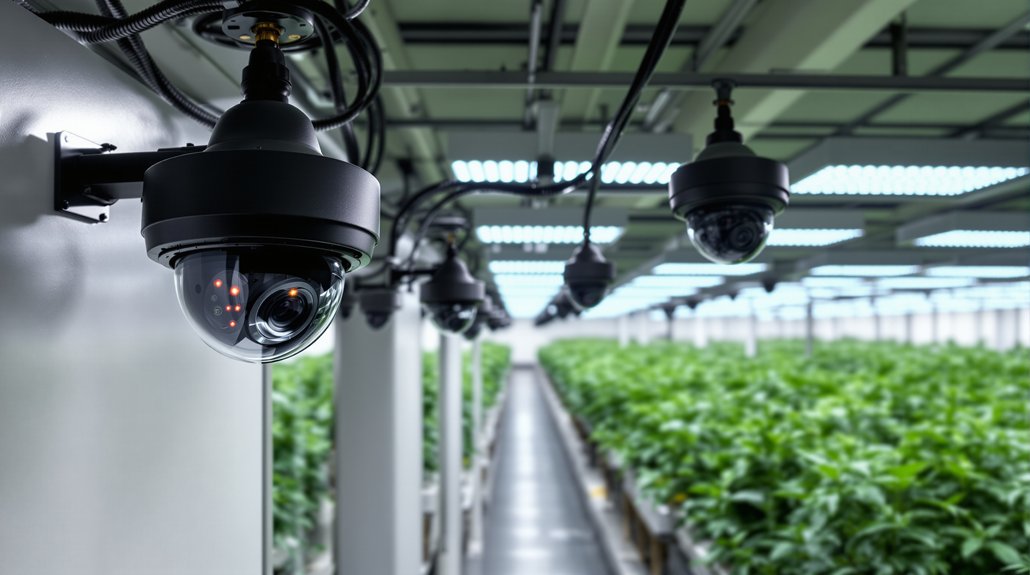
Thorough surveillance systems serve as the backbone of cannabis facility security, with regulatory agencies mandating extensive video monitoring requirements that far exceed those found in traditional retail environments.
Cannabis operators must implement 24/7 video surveillance across all areas where cannabis is present, including cultivation zones, storage facilities, sales floors, and waste disposal areas. Camera systems must meet minimum resolution standards, typically 720p or higher, with Oregon requiring 1280×720 pixels for compliance. Integration with track-and-trace systems like Metrc can enhance accountability by connecting visual records with inventory movements throughout the supply chain.
Network Video Recorders are preferred over traditional DVR systems due to their superior image quality and audio recording capabilities. Critical coverage points include all entry and exit locations, points of sale, and areas within ten feet of exterior fencing at outdoor facilities. 360-degree cameras provide comprehensive area coverage for facilities requiring extensive surveillance oversight.
Video footage must be retained for 30 to 90 days depending on state regulations, with tamper-resistant systems preventing unauthorized access or deletion. Many jurisdictions require off-site mirrored backups to guarantee footage preservation during hardware failures. Modern systems incorporate video analytics technology to automatically detect suspicious activity and alert security personnel to potential threats.
Transportation Security and Chain of Custody Requirements
Beyond the stationary security measures that protect cannabis facilities, regulatory frameworks impose equally stringent requirements for product movement between licensed locations.
Transportation protocols mandate that cannabis products remain completely concealed within vehicles, stored in locked containers secured inside the transport compartment. Two-person crews must accompany all shipments, with one member maintaining constant vehicle supervision to prevent theft or tampering.
Cannabis transport requires locked containers, concealed storage, and mandatory two-person crews with continuous vehicle supervision to prevent theft.
Electronic shipping manifests serve as the foundation of chain of custody documentation, requiring unique identification codes from cultivation sources and predetermined route information. Physical copies must accompany drivers during transport, available for immediate law enforcement inspection.
Real-time GPS tracking systems monitor vehicle locations within geofenced boundaries, while alarm systems provide additional security layers. Fleet vehicles must incorporate climate-control systems to maintain product integrity throughout the transportation process.
Only licensed distributors with secure transporter permits can conduct cannabis transportation between permitted commercial operations. Drivers must maintain chauffeur’s licenses and clean driving records, with strict prohibitions against route deviations. Transportation facilities must operate within zoning districts that specifically allow cannabis distribution activities.
Any incidents, theft, or product loss requires immediate reporting to regulatory authorities within twenty-four hours.
Regulatory Compliance and Audit Preparation
Cannabis businesses operate within one of the most heavily regulated commercial environments in the United States, where compliance failures can result in immediate license suspension, substantial financial penalties, or permanent closure.
Regulatory compliance requires thorough documentation systems that track every aspect of operations, from seed-to-sale monitoring to employee training records. Operators must maintain transaction, inventory, and security records for three to seven years, depending on jurisdiction requirements.
Electronic tracking systems fulfill state reporting obligations while documenting product movement throughout the supply chain. Standard Operating Procedures covering daily operations, compliance tasks, and corrective actions require detailed documentation and regular updates.
Audit preparation involves routine internal compliance reviews to identify regulatory gaps and operational risks. Compliance audits serve as a baseline for identifying gaps in operations and assessing adherence to regulatory requirements. Inventory reconciliation and random physical checks ensure system accuracy, while audit checklists cover physical security systems, digital access controls, and waste disposal procedures. Employee licensing requirements must be verified to ensure all staff maintain valid cannabis agent cards or occupational licenses as mandated by state regulations.
Immediate response protocols for rectifying discrepancies must be documented within established procedures. Labor Peace Agreements are required in several states including New York, California, and Illinois for cannabis businesses above certain size thresholds.
